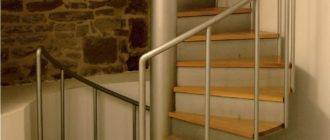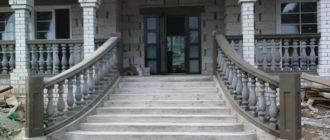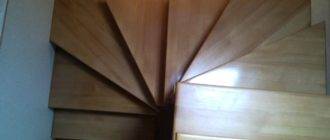There are several ways to assemble ladder structures. Something requires the work of specialists, but something can be assembled on your own.
One of these options also assumes that the ladder will be constructed on bowstrings.
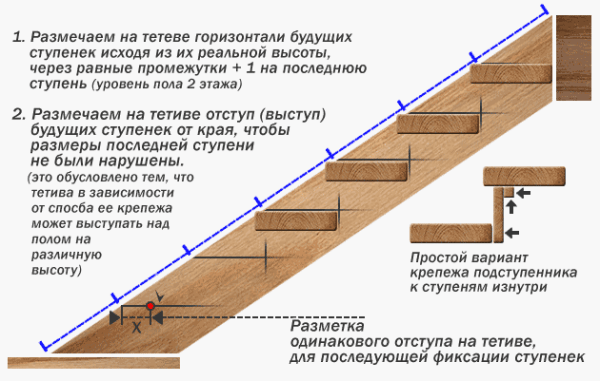
Bowstring in stairs
This raises a natural question, what is a ladder string? There is a fairly simple definition - this is the supporting bearing structure of the staircase, which is presented in the form of a beam with special cutouts on the inner side. The notches are designated as slots or slots and the steps are located in them.
This is not the only way to attach steps, but it is he who is considered classic. This type of fastening allows the steps to merge with the bowstring without showing their ends.
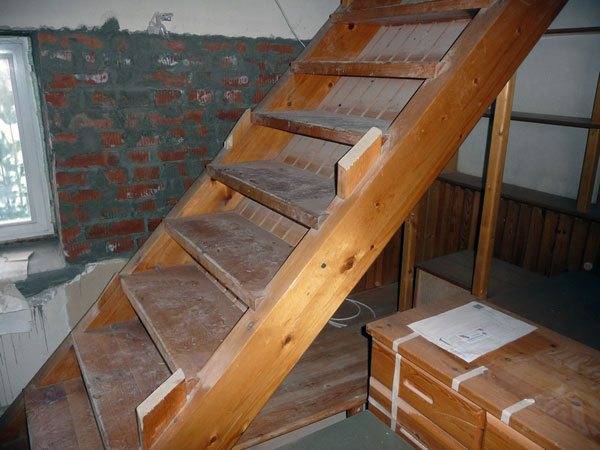
Material and dimensions
From the point of view of material, stringers for stairs can be made of wood or metal, as well as reinforced concrete.
Choosing wood as a material, you can go in two ways:
- Conifers, spruce, pine, fir, cedar... With all the advantages, these rocks emit resin, which can subsequently interfere with the normal staining of the staircase.
- Deciduous... Oak, maple, cherry, beech. This is the most preferable option (see also the article Oak stairs - manufacturing and assembly features).
The dimensions of the bowstring always depend on the length of the flight of stairs, however, you can give the standard dimensions for a wooden support beam, taking into account the width of 90 cm, this is at least 40 mm thick and 300 mm - the width of the beam. The depth of the slot of the nest is calculated at the level of 20-30 mm. (see also article Required width of a flight of stairs)
Important!
The size between the notches and the width of the nest in the lateral planes of the beam determine all the main characteristics of the span.
This is the width of the tread, and the height of the step and the angle of inclination of the structure.
Production
If we are talking about supporting beams made of wood, then making a bowstring for a staircase, first of all, will require choosing lumber, and the size in length and width should correspond to design recommendations. Thus, a solid beam is obtained, without splicing.
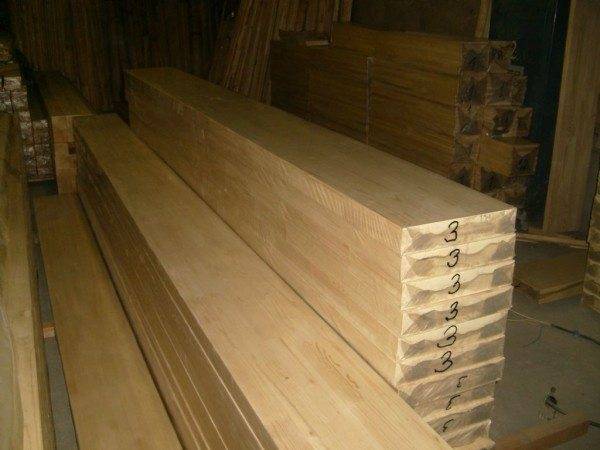
The minimum permissible size of the beam width is 275 mm, this is due to the fact that a string of at least 50 mm wide must remain above and below the steps.
The second step is the marking of the ladder bowstring, but here it is necessary to take into account that the actual number of steps in the flight of stairs will be less than the calculated one. It's just that the level of the floor of the second level is taken as a step.
The markup can be done in two simple ways:
- Using a corner and a ruler. But there is always a high risk of error.
- Using a specially prepared template.
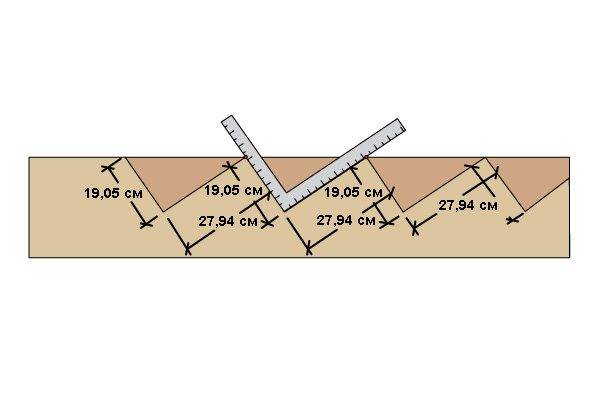
In addition, it is necessary to determine the variant of the location of the steps in relation to the bowstring.
And here there are also two options:
- No reference line. In this case, the groove is made open.
- With a reference line, tie-ins are made closed.
Important!
There is also a third option, in which the marking is carried out not for inserts, but for support mounts, overlays or metal corners.
Here it is drawn in the same way, taking into account the reference line.
The reference line is a traced line along the entire length of the edge of the beam, which is located at a certain, for example, 50 mm, distance from the edge of the beam.
All wooden blanks are treated with antiseptics and impregnated with a primer before work begins.
Payment
The instructions for calculating stairs are based on a formula that works for step length.
Schematically, you can display everything as follows:
- The average length of a human step is 60-66 cm, more precisely - 63 cm, respectively, the formula is used - 2 step heights + step depth = 63 ± 3 cm.
- In this case, the most optimal slope of the staircase is from 30 ° to 40 °.
- The depth of the step must correspond to shoe size 45, that is, be at least 28-30 cm. If even the bowstring cannot provide such depth, then the step is chosen wider, and the lack is compensated for by the protrusion.
Important!
The depth of the step plays a decisive role in the safe ascent and descent of any flight of stairs.
The height of the steps should be at the level of 15-20 cm.
Work on your own
Self-production of a flight of stairs begins with calculations and preparation of the necessary material. After that, do-it-yourself markup is done, and the manufacturing process begins directly.
To work, you will need certain tools:
- Roulette, ruler, square, building level
- Jigsaw.
- Manual milling machine.
- Drill.
- Hammer with rubber tip.
After marking, it is necessary to cut out the nests. This is quite easy to do with a hand-held milling machine, so the ladder string is fully prepared for the installation of steps.
Depending on the type of fastening of the steps, either a closed socket cutout or an open groove is made.
In the third option, the support connections are simply installed according to the marking.
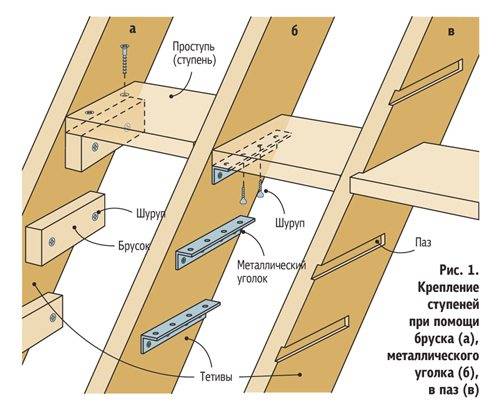
Next comes the fastening of the entire structure. Here it should be noted right away that the staircase bowstring adjoins directly to two planes, this is the staircase of the first floor, and the ceiling, or half of the second floor.
Thus, a certain load is placed on the landing. Any, including wooden ladders on bowstrings, are a static structure in which the beams are located on two supports. In addition, the ladder is always tilted.
It is precisely because of technical issues in the structure that the maximum load always falls on the lower support of the staircase, and both of the horizontal and vertical type.
But on the upper support, the load acts exclusively of the vertical type, and only if the bowstrings of the flight of stairs rest on the platform only in the horizontal plane.
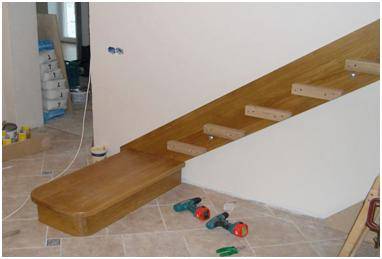
Fastening and installing the bowstring
In the event that the fastening of the bowstring of the wooden ladder passes against the wall, and this is the most preferable option, the wall beam must be carefully measured and sawed off from above, where it will rest on the cross beam of the opening, and from below, where the bowstring will lie flat on the floor plane.
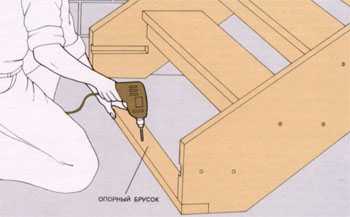
Important!
It will be possible to "plant" the entire structure on glue, and finally it will be possible to connect after the entire adjustment of the beams to the floor levels has been made.
Fitting the wall string at the top is done as follows:
- The assembled march is put on its side so that the attached bowstring is at the bottom, then a line is drawn along the inner side of the riser and the upper step.
- Now another line is drawn, which will go from the trailing edge of the frieze tread to the very level of the plinth; in practice, the most common line is 75 mm long.
- Further, the upper riser is removed, this option is reminded once again that the final installation is carried out after all the fittings, and the bowstring is sawn off along the specified guides.
- Regarding how the installation of the bowstring of the stairs along the floor line is done, it can be noted that here a line is drawn parallel to the lower tread along which the bottom of the beam is sawn off.
- Before installing the structure, it is necessary to make a recess on the upper support post, it is with its help that the post will fit tightly onto the upper floor. The excavation is always carried out directly when montage the entire flight of stairs, completely ready for installation.
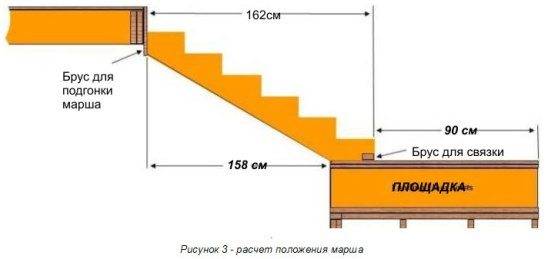
In addition, a ladder on bowstrings with your own hands involves the presence of dowels for fastening with upper and lower support posts. Naturally, special grooves for dowels must be made in the racks.
The entire flight of stairs is held under its own weight, however, for reliability, the flight is fastened with screws through the support posts to the beams, and through the bowstring to the wall.
It is very important to determine the method of fastening before attaching the string of the stairs to the floor, because it is in this area that a serious load will constantly be found.
The following types of fastening look most preferable:
- The support leg can be installed in a specially prepared hole in the floor screed.
- The support leg is secured with steel anchors.
The second option is much easier to implement in practice, especially considering that the work is being done independently.
Output
Among all designs, a ladder on a bowstring + built by your own hands is considered the simplest option. Especially if it is straightforward and consists of one march.
This design is suitable both for a private house or summer cottage, and for arranging an apartment on two levels.
Plus, this is a fairly inexpensive option for a flight of stairs, which does not even have to be done with fences, and in this case it will be enough just to purchase two beams and a board for steps. And in the video presented in this article, you will find additional information on this topic.


